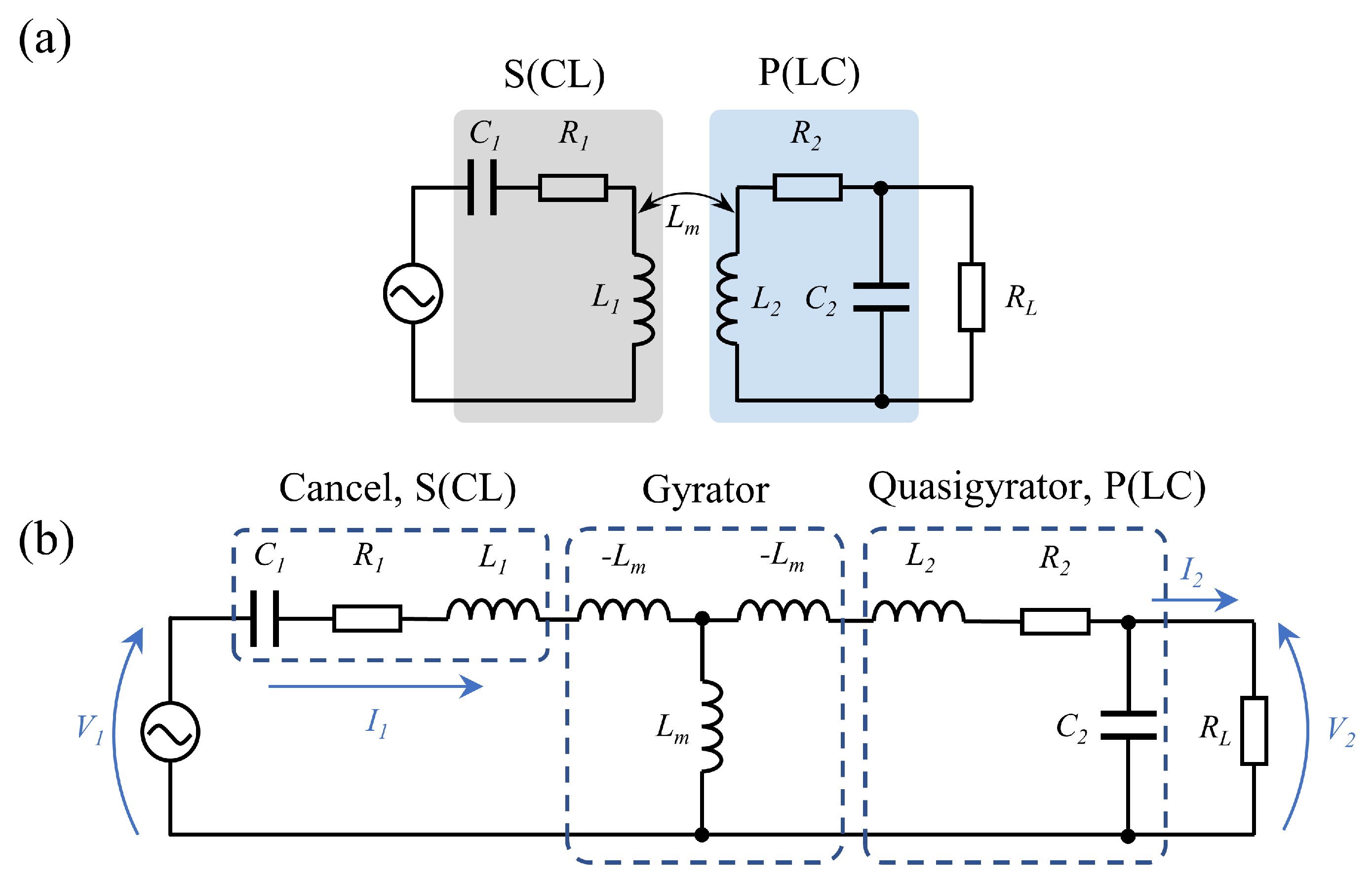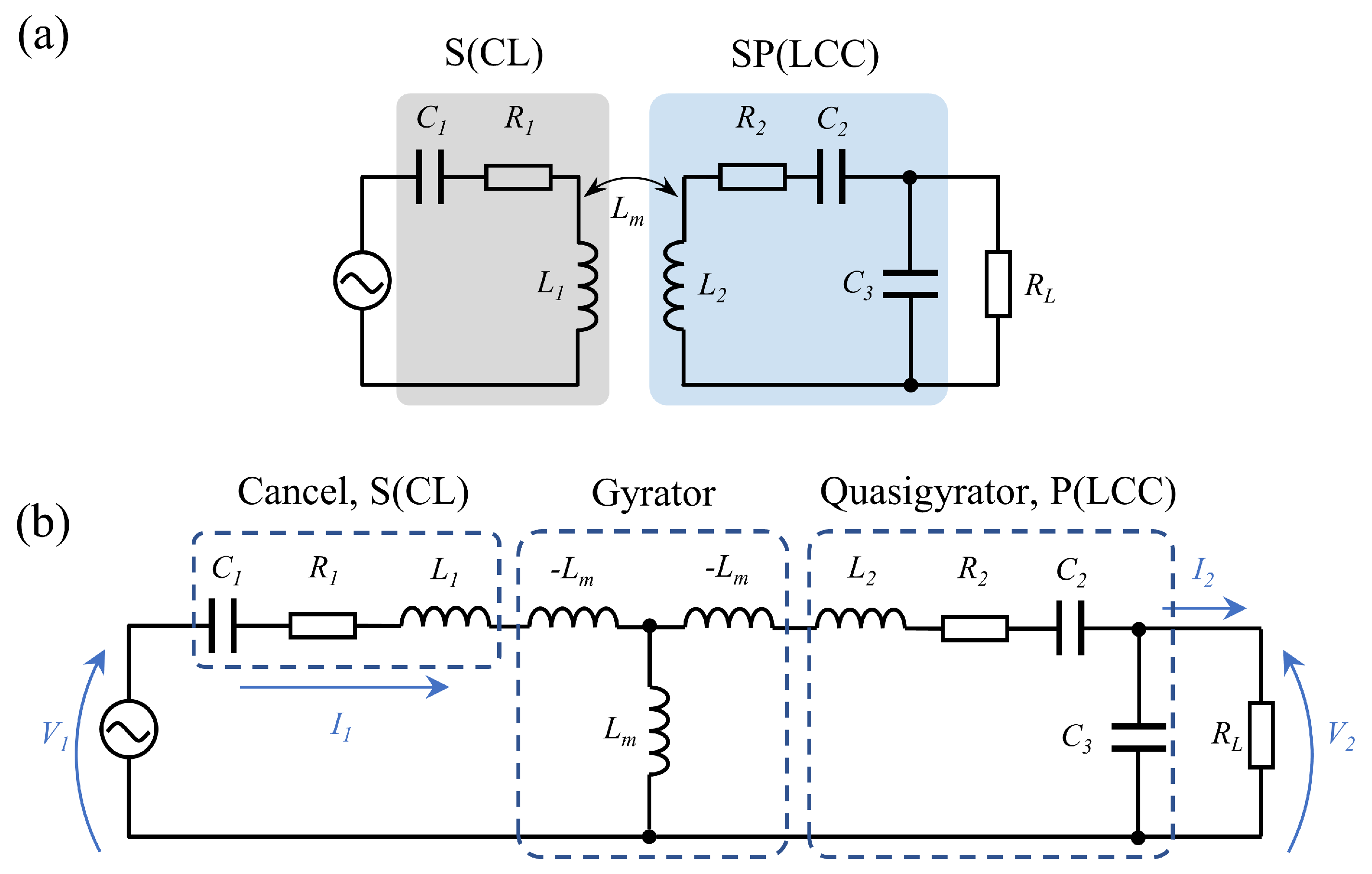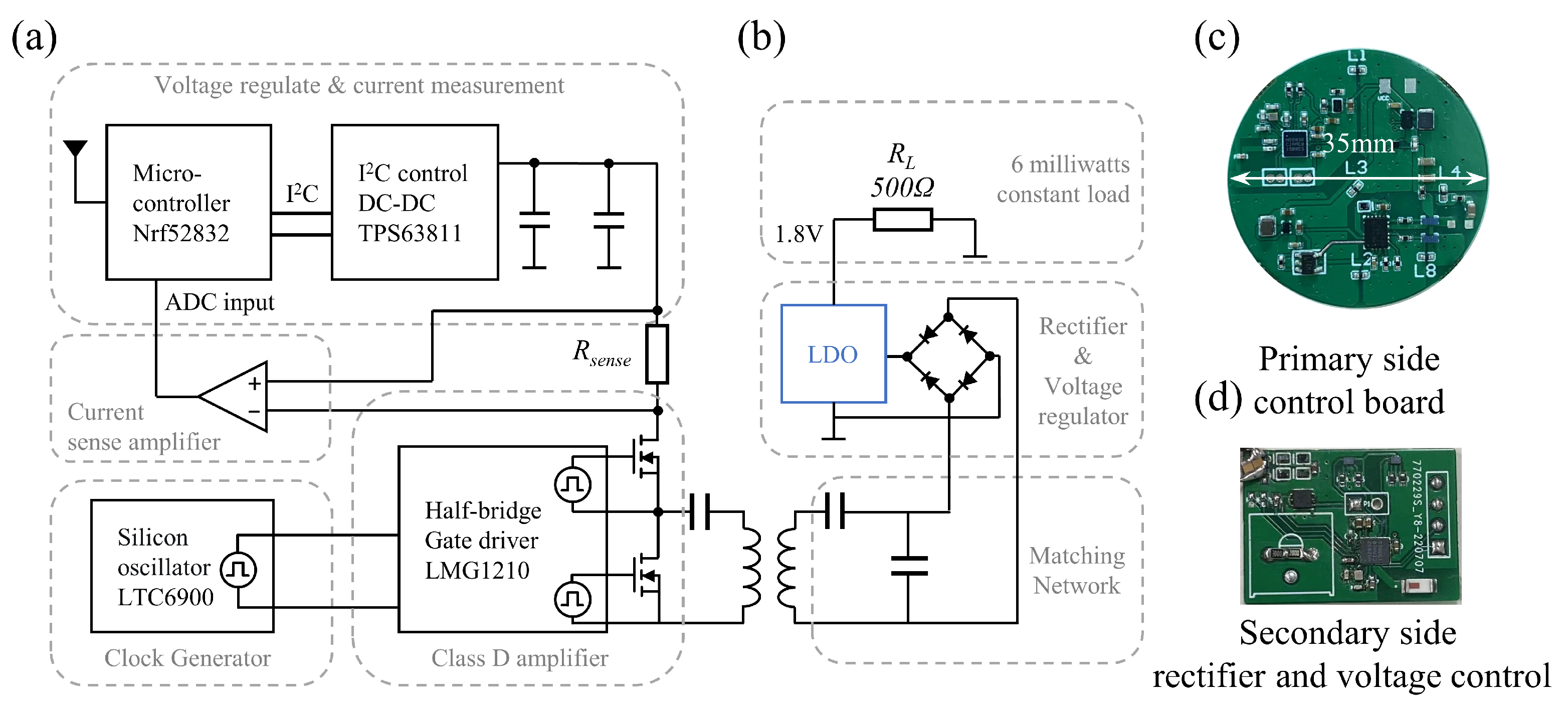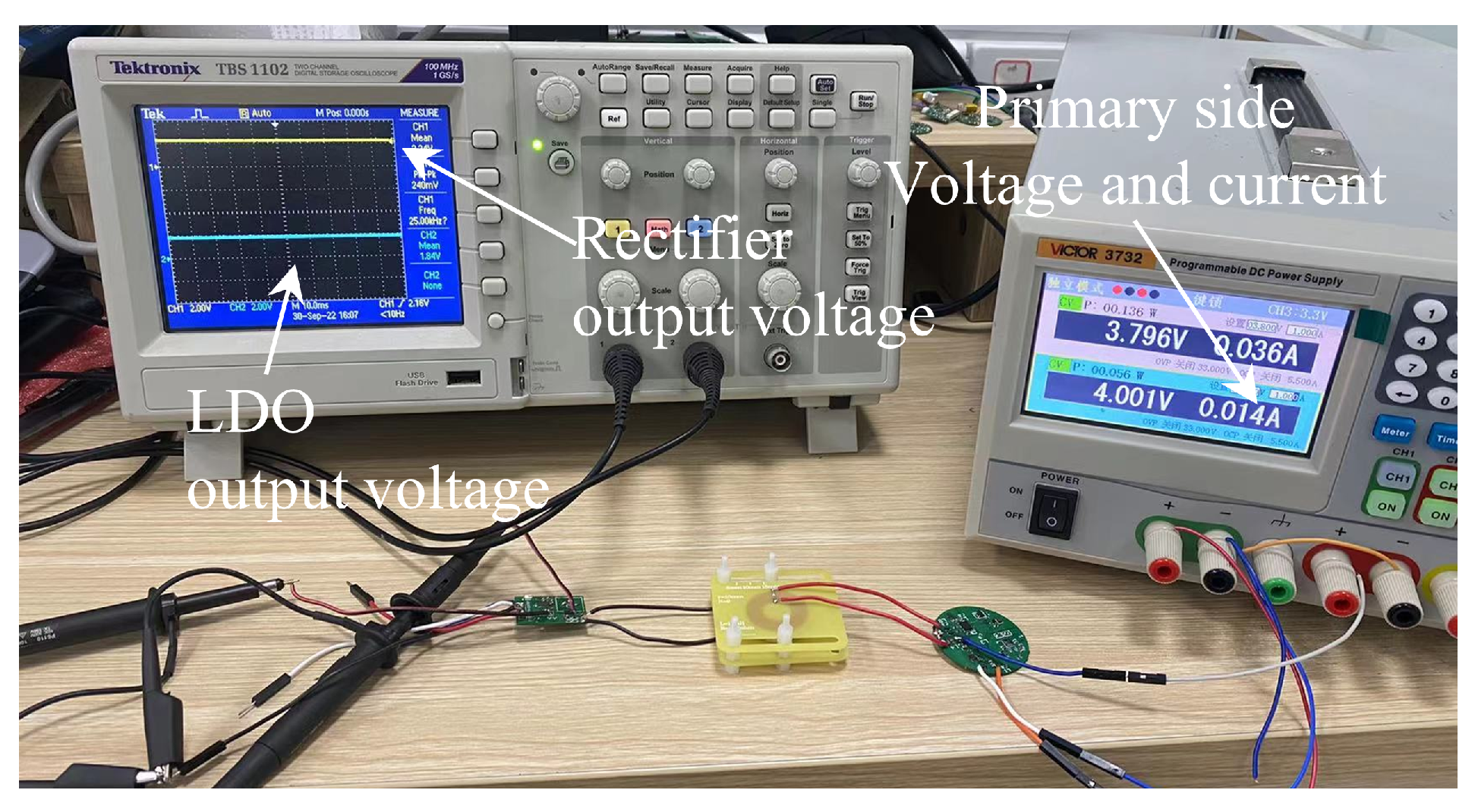A Linear-Power-Regulated Wireless Power Transfer Method for Decreasing the Heat Dissipation of Fully Implantable Microsystems
Abstract
:1. Introduction
2. Materials and Methods
2.1. Parameter Analysis of the Wireless Power Transfer System
2.2. An LDO-Based Linear-Power-Regulated Wireless Power Transfer Method
2.3. A Miniaturized Linear-Power-Regulated Wireless Power Transfer System
3. Results
3.1. Measurement of Linear-Power-Regulated Wireless Power Transfer System
3.2. Measurement and Analysis of Wireless Power Transfer Efficiency
4. Discussion
5. Conclusions
Author Contributions
Funding
Institutional Review Board Statement
Informed Consent Statement
Data Availability Statement
Acknowledgments
Conflicts of Interest
Abbreviations
| FCC | Federal Communications Commission |
| SAR | Specific absorption rate |
| BCI | Brain-computer interfaces |
| WPT | Wireless power transfer |
References
- Luan, L.; Robinson, J.T.; Aazhang, B.; Chi, T.; Yang, K.; Li, X.; Rathore, H.; Singer, A.; Yellapantula, S.; Fan, Y.; et al. Recent advances in electrical neural interface engineering: Minimal invasiveness, longevity, and scalability. Neuron 2020, 108, 302–321. [Google Scholar] [CrossRef]
- Yan, T.; Kameda, S.; Suzuki, K.; Kaiju, T.; Inoue, M.; Suzuki, T.; Hirata, M. Minimal Tissue Reaction after Chronic Subdural Electrode Implantation for Fully Implantable Brain–Machine Interfaces. Sensors 2020, 21, 178. [Google Scholar] [CrossRef] [PubMed]
- Mutlu, S. Challenges in Neural Interface Electronics: Miniaturization and Wireless Operation. In Somatosensory Feedback for Neuroprosthetics; Elsevier: Amsterdam, The Netherlands, 2021; pp. 537–559. [Google Scholar]
- Yang, K.W.; Oh, K.; Ha, S. Challenges in scaling down of free-floating implantable neural interfaces to millimeter scale. IEEE Access 2020, 8, 133295–133320. [Google Scholar] [CrossRef]
- Jin, P.; Fu, J.; Wang, F.; Zhang, Y.; Wang, P.; Liu, X.; Jiao, Y.; Li, H.; Chen, Y.; Ma, Y.; et al. A flexible, stretchable system for simultaneous acoustic energy transfer and communication. Sci. Adv. 2021, 7, eabg2507. [Google Scholar] [CrossRef] [PubMed]
- Dinis, H.; Mendes, P. A comprehensive review of powering methods used in state-of-the-art miniaturized implantable electronic devices. Biosens. Bioelectron. 2021, 172, 112781. [Google Scholar] [CrossRef] [PubMed]
- Kim, C.Y.; Ku, M.J.; Qazi, R.; Nam, H.J.; Park, J.W.; Nam, K.S.; Oh, S.; Kang, I.; Jang, J.H.; Kim, W.Y.; et al. Soft subdermal implant capable of wireless battery charging and programmable controls for applications in optogenetics. Nat. Commun. 2021, 12, 535. [Google Scholar] [CrossRef]
- Jia, Y.; Mirbozorgi, S.A.; Lee, B.; Khan, W.; Madi, F.; Inan, O.T.; Weber, A.; Li, W.; Ghovanloo, M. A mm-sized free-floating wirelessly powered implantable optical stimulation device. IEEE Trans. Biomed. Circuits Syst. 2019, 13, 608–618. [Google Scholar] [CrossRef] [PubMed]
- Bailey, W.H.; Bodemann, R.; Bushberg, J.; Chou, C.K.; Cleveland, R.; Faraone, A.; Foster, K.R.; Gettman, K.E.; Graf, K.; Harrington, T.; et al. Synopsis of IEEE Std C95.1TM-2019 “IEEE Standard for Safety Levels With Respect to Human Exposure to Electric, Magnetic, and Electromagnetic Fields, 0 Hz to 300 GHz”. IEEE Access 2019, 7, 171346–171356. [Google Scholar] [CrossRef]
- Code, S. Limits of Human Exposure to Radiofrequency Electromagnetic Energy in the Frequency Range from 3 khz to 300 ghz; Health Canada: Ottawa, ON, Canada, 2015. [Google Scholar]
- Park, J.; Kim, C.; Akinin, A.; Ha, S.; Cauwenberghs, G.; Mercier, P.P. Wireless Powering of MM-Scale Fully-on-Chip Neural Interfaces. In Proceedings of the 2017 IEEE Biomedical Circuits and Systems Conference (BioCAS), Torino, Italy, 19–21 October 2017; pp. 1–4. [Google Scholar]
- Markvart, A.; Song, M.; Glybovski, S.; Belov, P.; Simovski, C.; Kapitanova, P. Metasurface for near-field wireless power transfer with reduced electric field leakage. IEEE Access 2020, 8, 40224–40231. [Google Scholar] [CrossRef]
- Huang, Z.; Wong, S.C.; Chi, K.T. Comparison of basic inductive power transfer systems with linear control achieving optimized efficiency. IEEE Trans. Power Electron. 2019, 35, 3276–3286. [Google Scholar] [CrossRef]
- Zhang, W.; Wong, S.C.; Chi, K.T.; Chen, Q. Load-independent duality of current and voltage outputs of a series-or parallel-compensated inductive power transfer converter with optimized efficiency. IEEE J. Emerg. Sel. Top. Power Electron. 2014, 3, 137–146. [Google Scholar] [CrossRef]
- Schormans, M.; Valente, V.; Demosthenous, A. Practical inductive link design for biomedical wireless power transfer: A tutorial. IEEE Trans. Biomed. Circuits Syst. 2018, 12, 1112–1130. [Google Scholar] [CrossRef] [Green Version]
- Shevchenko, V.; Husev, O.; Strzelecki, R.; Pakhaliuk, B.; Poliakov, N.; Strzelecka, N. Compensation topologies in IPT systems: Standards, requirements, classification, analysis, comparison and application. IEEE Access 2019, 7, 120559–120580. [Google Scholar] [CrossRef]
- Miura, N.; Kodera, S.; Diao, Y.; Higashiyama, J.; Suzuki, Y.; Hirata, A. Power absorption and skin temperature rise from simultaneous near-field exposure at 2 and 28 GHz. IEEE Access 2021, 9, 152140–152149. [Google Scholar] [CrossRef]
- Yang, Y.; Wu, M.; Vázquez-Guardado, A.; Wegener, A.J.; Grajales-Reyes, J.G.; Deng, Y.; Wang, T.; Avila, R.; Moreno, J.A.; Minkowicz, S.; et al. Wireless multilateral devices for optogenetic studies of individual and social behaviors. Nat. Neurosci. 2021, 24, 1035–1045. [Google Scholar] [CrossRef]
- Jia, Y.; Guler, U.; Lai, Y.P.; Gong, Y.; Weber, A.; Li, W.; Ghovanloo, M. A trimodal wireless implantable neural interface system-on-chip. IEEE Trans. Biomed. Circuits Syst. 2020, 14, 1207–1217. [Google Scholar] [CrossRef] [PubMed]
- Khalifa, A.; Liu, Y.; Karimi, Y.; Wang, Q.; Eisape, A.; Stanaćević, M.; Thakor, N.; Bao, Z.; Etienne-Cummings, R. The microbead: A 0.009 mm3 implantable wireless neural stimulator. IEEE Trans. Biomed. Circuits Syst. 2019, 13, 971–985. [Google Scholar] [CrossRef] [PubMed]
- Leene, L.B.; Maslik, M.; Feng, P.; Szostak, K.M.; Mazza, F.; Constandinou, T.G. Autonomous SoC for Neural Local Field Potential Recording in MM-Scale Wireless Implants. In Proceedings of the 2018 IEEE International Symposium on Circuits and Systems (ISCAS), Florence, Italy, 27–30 May 2018; pp. 1–5. [Google Scholar]
- Jia, Y.; Mirbozorgi, S.A.; Lee, B.; Khan, W.; Madi, F.; Weber, A.; Li, W.; Ghovanloo, M. A MM-Sized Free-Floating Wirelessly Powered Implantable Optical Stimulating System-on-a-Chip. In Proceedings of the 2018 IEEE International Solid-State Circuits Conference-(ISSCC), San Francisco, CA, USA, 11–15 February 2018; pp. 468–470. [Google Scholar]
- Ahire, D.; Gond, V.J.; Chopade, J.J. Compensation topologies for wireless power transmission system in medical implant applications: A review. Biosens. Bioelectron. X 2022, 11, 100180. [Google Scholar] [CrossRef]
- Imura, T. Wireless Power Transfer: Using Magnetic and Electric Resonance Coupling Techniques; Springer Nature: Berlin/Heidelberg, Germany, 2020. [Google Scholar]
- Zhang, W.; Wong, S.C.; Chi, K.T.; Chen, Q. Analysis and comparison of secondary series-and parallel-compensated inductive power transfer systems operating for optimal efficiency and load-independent voltage-transfer ratio. IEEE Trans. Power Electron. 2013, 29, 2979–2990. [Google Scholar] [CrossRef]
- Su, L.; Ma, D.; Brokaw, A.P. Design and analysis of monolithic step-down SC power converter with subthreshold DPWM control for self-powered wireless sensors. IEEE Trans. Circuits Syst. I Regul. Pap. 2009, 57, 280–290. [Google Scholar]
- Ciarpi, G.; Saponara, S. Inductorless DC/DC converter for aerospace applications with insulation features. IEEE Trans. Circuits Syst. II Express Briefs 2020, 67, 1659–1663. [Google Scholar] [CrossRef]
- Carreon-Bautista, S.; Erbay, C.; Han, A.; Sanchez-Sinencio, E. An inductorless DC–DC converter for an energy aware power management unit aimed at microbial fuel cell arrays. IEEE J. Emerg. Sel. Top. Power Electron. 2015, 3, 1109–1121. [Google Scholar] [CrossRef]
- Stoecklin, S.; Yousaf, A.; Gidion, G.; Reindl, L.; Rupitsch, S.J. Simultaneous power feedback and maximum efficiency point tracking for miniaturized rf wireless power transfer systems. Sensors 2021, 21, 2023. [Google Scholar] [CrossRef] [PubMed]
- Yeo, T.D.; Kwon, D.; Khang, S.T.; Yu, J.W. Design of maximum efficiency tracking control scheme for closed-loop wireless power charging system employing series resonant tank. IEEE Trans. Power Electron. 2016, 32, 471–478. [Google Scholar] [CrossRef]
- Li, H.; Li, J.; Wang, K.; Chen, W.; Yang, X. A maximum efficiency point tracking control scheme for wireless power transfer systems using magnetic resonant coupling. IEEE Trans. Power Electron. 2014, 30, 3998–4008. [Google Scholar] [CrossRef]
- Narusue, Y.; Kawahara, Y.; Asami, T. Variable-Hop Impedance Matching Method for Magnetic Resonance Based Wireless Power Transmission Relays; IEICE Technical Report; The Institute of Electronics, Information and Communication Engineers (IEICE): Tokyo, Japan, 2012. [Google Scholar]
- Koh, K.E.; Imura, T.; Hori, Y. Impedance Inverter Based Analysis of Wireless Power Transfer Consists of Repeaters via Magnetic Resonant Coupling; Technical Report, IEICE Technical Report, WPT2012-37; The Institute of Electronics, Information and Communication Engineers (IEICE): Tokyo, Japan, 2012. [Google Scholar]
- Koh, K.E.; Beh, T.C.; Imura, T.; Hori, Y. Impedance matching and power division using impedance inverter for wireless power transfer via magnetic resonant coupling. IEEE Trans. Ind. Appl. 2013, 50, 2061–2070. [Google Scholar] [CrossRef]
- Zhong, W.; Xu, D.; Hui, R.S.Y.; Xu, D.; Hui, R.S.Y. Wireless Power Transfer: Between Distance and Efficiency; Springer: Berlin/Heidelberg, Germany, 2020. [Google Scholar]
- Hou, J.; Chen, Q.; Yan, K.; Ren, X.; Wong, S.C.; Tse, C.K. Analysis and Control of S/SP Compensation Contactless Resonant Converter with Constant Voltage Gain. In Proceedings of the 2013 IEEE Energy Conversion Congress and Exposition, Denver, CO, USA, 15–19 September 2013; pp. 2552–2558. [Google Scholar]
- Iero, D.; Carotenuto, R.; Merenda, M.; Pezzimenti, F.; Della Corte, F.G. Performance Evaluation of Silicon and GaN Switches for a Small Wireless Power Transfer System. Energies 2022, 15, 3029. [Google Scholar] [CrossRef]
- Kao, S.K.; Chen, J.J.; Liao, C.H. A Multipath Output-Capacitor-Less LDO Regulator. IEEE Access 2022, 10, 27185–27196. [Google Scholar] [CrossRef]
- Guo, Z.; Li, D.; Zhang, B.; Xue, Z.; Dong, L.; Chen, Z.; Xiong, Y.; Geng, L. Highly Efficient Fully Integrated Multivoltage-Domain Power Management With Enhanced PSR and Low Cross-Regulation. IEEE Trans. Power Electron. 2021, 36, 11469–11482. [Google Scholar] [CrossRef]
- George, L.; Gargiulo, G.D.; Lehmann, T.; Hamilton, T.J. A 0.04 mm2 Buck-Boost DC-DC Converter for Biomedical Implants Using Adaptive Gain and Discrete Frequency Scaling Control. IEEE Trans. Biomed. Circuits Syst. 2015, 10, 668–678. [Google Scholar] [CrossRef]
- Lee, J.; Leung, V.; Lee, A.H.; Huang, J.; Asbeck, P.; Mercier, P.P.; Shellhammer, S.; Larson, L.; Laiwalla, F.; Nurmikko, A. Neural recording and stimulation using wireless networks of microimplants. Nat. Electron. 2021, 4, 604–614. [Google Scholar] [CrossRef]
- Mirbozorgi, S.A.; Yeon, P.; Ghovanloo, M. Robust wireless power transmission to mm-sized free-floating distributed implants. IEEE Trans. Biomed. Circuits Syst. 2017, 11, 692–702. [Google Scholar] [CrossRef]
- Smirnov, P.; Kapitanova, P.; Nenasheva, E.; Song, M. Compact Hybrid Metasurface-Inspired Resonator with Uniform Magnetic Field Distribution for Wireless Power Transfer. IEEE Antennas Wirel. Propag. Lett. 2021, 21, 193–197. [Google Scholar] [CrossRef]
- Cho, Y.; Lee, S.; Kim, D.H.; Kim, H.; Song, C.; Kong, S.; Park, J.; Seo, C.; Kim, J. Thin hybrid metamaterial slab with negative and zero permeability for high efficiency and low electromagnetic field in wireless power transfer systems. IEEE Trans. Electromagn. Compat. 2017, 60, 1001–1009. [Google Scholar] [CrossRef]
- Cho, Y.; Lee, S.; Jeong, S.; Kim, H.; Song, C.; Yoon, K.; Song, J.; Kong, S.; Yun, Y.; Kim, J. Hybrid Metamaterial with Zero and Negative Permeability to Enhance Efficiency in Wireless Power Transfer System. In Proceedings of the 2016 IEEE Wireless Power Transfer Conference (WPTC), Aveiro, Portugal, 5–6 May 2016; pp. 1–3. [Google Scholar]









| Coil | Turns | Diameter (mm) | Inductance (nH) | Resistance (m) | Lm (nH) |
|---|---|---|---|---|---|
| transmitter | 9 | 10 | 1500 | 160 | 400 (d = 5 mm) |
| receiver | 5 | 10 | 800 | 100 |
| Type | LDO | DC-DC | |||
|---|---|---|---|---|---|
| Reference | [38] | [39] | [40] | [28] | [27] |
| Year | 2022 | 2021 | 2015 | 2015 | 2020 |
| Chip Area (mm) | 0.128 | 0.49 | 0.04 | 1.8 | 36 |
| CMOS Process (m) | 0.18 | 0.18 | 0.18 | 0.18 | 0.35 |
| Input voltage (V) | 1.2–1.8 | 3.3–3.6 | 1.8 | 6–60 | 0.3–0.4 |
| Output voltage (V) | 1 | 0.8–3.2 | 1.0–2.2 | 1.65, 5 | 1.6–2 |
| Efficiency | 83% (max) | 96.5% (max) | 30–75% | 65% (max) | 40–65% |
Publisher’s Note: MDPI stays neutral with regard to jurisdictional claims in published maps and institutional affiliations. |
© 2022 by the authors. Licensee MDPI, Basel, Switzerland. This article is an open access article distributed under the terms and conditions of the Creative Commons Attribution (CC BY) license (https://creativecommons.org/licenses/by/4.0/).
Share and Cite
Wang, H.; Zhu, C.; Jin, W.; Tang, J.; Wu, Z.; Chen, K.; Hong, H. A Linear-Power-Regulated Wireless Power Transfer Method for Decreasing the Heat Dissipation of Fully Implantable Microsystems. Sensors 2022, 22, 8765. https://doi.org/10.3390/s22228765
Wang H, Zhu C, Jin W, Tang J, Wu Z, Chen K, Hong H. A Linear-Power-Regulated Wireless Power Transfer Method for Decreasing the Heat Dissipation of Fully Implantable Microsystems. Sensors. 2022; 22(22):8765. https://doi.org/10.3390/s22228765
Chicago/Turabian StyleWang, Haochuan, Chenglong Zhu, Wenkai Jin, Junjie Tang, Zhanxiong Wu, Keming Chen, and Hui Hong. 2022. "A Linear-Power-Regulated Wireless Power Transfer Method for Decreasing the Heat Dissipation of Fully Implantable Microsystems" Sensors 22, no. 22: 8765. https://doi.org/10.3390/s22228765





